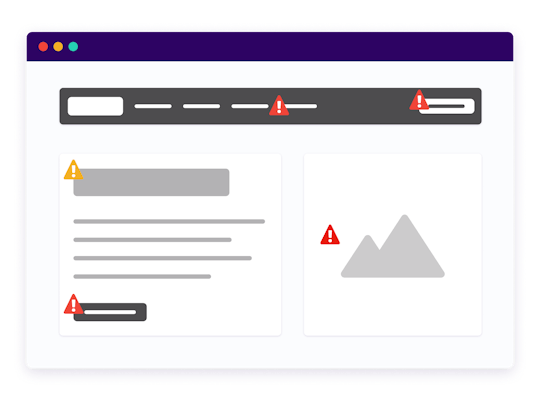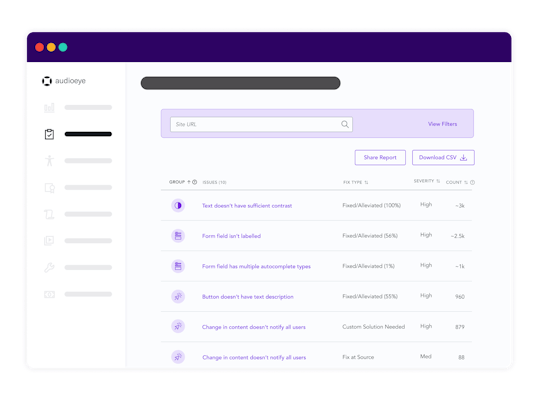WEBSITE ACCESSIBILITY CHECKER
How Accessible Is Your Website?
AudioEye gives you real-time insights into the accessibility issues on your website to help you create inclusive, barrier-free content for all your audiences, regardless of their ability. Begin your path to website accessibility compliance by testing a webpage with the Website Accessibility Checker.
How to check your website for accessibility and compliance
The Website Accessibility Checker makes it easier to start testing your website for accessibility.

AudioEye’s automated issue detection software tests elements generated from the source code of your webpage against accessible coding frameworks like the Web Content Accessibility Guidelines (WCAG) to uncover accessibility issues.

You’ll receive a detailed report of the most severe and commonly found issues and recommendations for steps to take to become ADA-compliant.

Start fixing your website accessibility issues with AudioEye’s combination of automated and custom remediations, and begin your path to ADA compliance.
What is website accessibility?
Website accessibility is the practice of designing a website in a way that people with disabilities can easily navigate, consume, and interact with its content. Only 3% of the internet is accessible for people with disabilities.
From including descriptive alt text with images for users with vision impairments to adding closed captions to videos for those with hearing impairments, there are many details to designing an accessible website. We’ve compiled a checklist of some of the most common to help you get a start on understanding and incorporating website accessibility best practices. The exhaustive list of accessible website criteria and its foundational principles can be found in the Web Content Accessibility Guidelines (WCAG) 2.1, the global standard for website accessibility.
What are the WCAG guidelines?
The Web Content Accessibility Guidelines (WCAG), created by the World Wide Web Consortium (W3C), are a set of web standards that aim to make the internet a more inclusive and accessible space for all.
Following WCAG guidelines is best practice for ensuring your website is accessible for users with disabilities. Furthermore, conforming with WCAG is a major part of being compliant with the ADA and other accessibility laws and regulations.
AudioEye’s Website Accessibility Checker tests the elements of your website’s source code against specific WCAG criterion.
Why it’s important that your website is accessible
According to the Americans with Disabilities Act (ADA), places of public accommodation, including websites, must be accessible to people of all abilities. A website that is not accessible not only fails to meet the needs of a sizable number of its users, but increases the legal exposure to an accessibility lawsuit.
What is website accessibility compliance?
Website accessibility compliance is the process to ensure that a business follows the laws and guidelines around web accessibility.
Website accessibility compliance and accessibility itself are not the same. While making your website accessible follows a defined set of guidelines, making it compliant follows a less clearly defined set of legal precedent. Nonetheless, following the WCAG guidelines to make your website accessible is a major part of staying in compliance with the law.
What is ADA compliance?
The Americans with Disabilities Act (ADA) prohibits discrimination against individuals with disabilities in all areas of public life, including businesses. While the ADA does not explicitly mention the website accessibility, subsequent legal rulings have established that businesses must accommodate individuals with disabilities on the internet just as they do in physical places of business.
Specifically, businesses with websites can conform (or abide by a set of implicit rules) to the ADA by making “reasonable accommodations” for people with disabilities.
To have a sufficient compliance plan with the ADA and other accessibility laws and guidelines, you should have:
- A website accessibility testing and remediation plan
- An accessibility statement
- Periodic manual audits of your website accessibility
- An available grievance procedure
Scan Your Website
Find out how accessible your site is with our Website Accessibility Checker.
Frequently Asked Questions
Have more questions? Feel free to hit us up on our chat—we’d love to help you out!
How does the website accessibility checker work?
What can I do with my Accessibility Compliance Score?
Does the Website Accessibility Checker make my website accessible?
Does the Website Accessibility Checker make my website compliant?
How do I test my website for WCAG guidelines?
How do I share an audit with my clients?
Can I test more than one page for free? What about more than one website?
View all FAQ